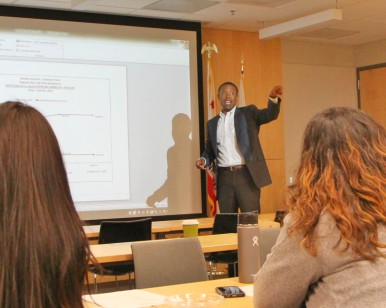San Rafael, CA – Saying that the County of Marin is making progress on social equity in its workforce is one thing. Proving it is another. Now, the County is taking a results-oriented approach to the issue and has shared its findings online with the public.
 Roger Crawford, the County's Equal Opportunity Employment Director, speaks to a County employee group about the demographic makeup of the staff.
Roger Crawford, the County's Equal Opportunity Employment Director, speaks to a County employee group about the demographic makeup of the staff.
The new
interactive dashboard was rolled out this week to the
County’s website. In the equity package, statistics from December 31, 2013, through December 31, 2017, provide a snapshot in time about the County of Marin’s workforce demographics. There are charts that present details about the ethnicity, gender, and age ranges in the County workforce, including a departmental breakdown. The
source data used by the dashboard can also be found in its raw form on
Marin County Open Data.
The data shows an accurate reflection of demographic trends experienced in greater Marin County, with the percentage of Latino, Asian and Undeclared workers growing and the percentage of white workers decreasing. The percentage of African American employees has been flat with a slight decrease in 2017. The gender figures show a workforce that is 56.6 percent female, up 2 percent over the five-year span.
The County’s Department of Information Services and Technology (IST) collaborated with the Human Resources Department to compile the information and share it online.
“Dashboard viewers can select options to gain insight about our workforce and answer questions they might have,” said Wesley Hill, who oversees the Open Data program for IST. “Perhaps you want to chart the upward mobility of a Latina woman in a technical role. This dashboard allows users to play around and make their own conclusions.”
Roger Crawford, the County’s Equal Opportunity Employment Director, has been heavily involved in the County’s efforts in improving diversity in its workforce.
“We have talked a lot in recent years about it, but it’s not enough just to set goals,” Crawford said. “Part of our approach is using clear and transparent data to promote accountability and to benchmark where the County needs to focus its efforts. Using data also helps the County assess whether its goals need to be adjusted over time to achieve the desired results.”
Marin County Open Data, launched in 2017, features data sets ranging from emergency medical response rates to food safety inspection results to kindergarten immunization rates. The goal is to share data, start conversations, foster analysis and discuss potential solutions to the hot-button issues. The data archive can be accessed quickly at data.marincounty.org. IST personnel have been working to enhance access to information and self-service for several years and is eager to engage with the local software development community about the most effective ways to use the information.
The roots of the data-sharing effort are traced to the Marin County Board of Supervisors’ 5 Year Business Plan, approved in October 2015, which included a vision of being a more responsive government with innovation as a core value. One strategy is to increase online options for the community to conduct business with the County or learn more about the services it provides. Specifically on the topic of equity, the plan read, “The increase in diversity in both our employee population and our residents calls for a greater commitment to cultural competency and the inclusion of those with multiple perspectives and backgrounds in our decision making.”
One of the first public uses of Marin County Open Data was in April 2017 when the County hosted its first hackathon for students. At the Hack4Health event, participants downloaded raw data to devise technical solutions to health challenges that could benefit residents of Marin. Earlier this year, IST shared data about countywide sustainability efforts and extensive local crime statistics.